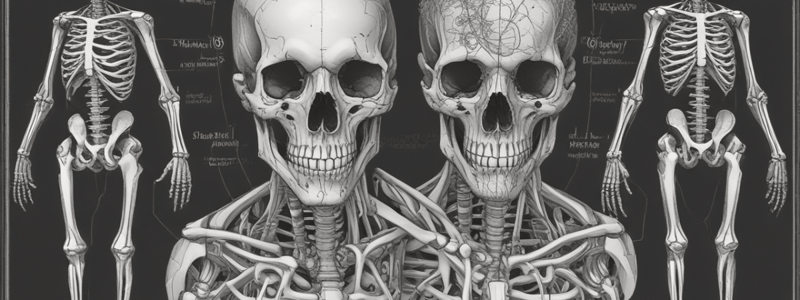Podcast
Questions and Answers
What is the primary purpose of learning the terms for common bone markings?
What is the primary purpose of learning the terms for common bone markings?
To help learn about specific bones described in the chapter
What type of surface features tend to be smooth areas on bones?
What type of surface features tend to be smooth areas on bones?
Articulating surfaces between adjacent bones
What do depressions on a bone provide space for?
What do depressions on a bone provide space for?
A bony articulation, muscular structure, or other body component
What do openings and spaces through bones indicate?
What do openings and spaces through bones indicate?
What is the meaning of the term 'foramen' in anatomy?
What is the meaning of the term 'foramen' in anatomy?
What is the difference between a foramen and a fissure?
What is the difference between a foramen and a fissure?
What are the two main divisions of the skeletal system and what are their main functions?
What are the two main divisions of the skeletal system and what are their main functions?
Which bones are part of the axial skeleton and what is their primary function?
Which bones are part of the axial skeleton and what is their primary function?
What is the difference between the axial skeleton and the appendicular skeleton in terms of their functions and components?
What is the difference between the axial skeleton and the appendicular skeleton in terms of their functions and components?
What is the significance of the axial skeleton in terms of blood cell formation?
What is the significance of the axial skeleton in terms of blood cell formation?
What are the components of the appendicular skeleton and what is their primary function?
What are the components of the appendicular skeleton and what is their primary function?
What is the difference between the pectoral girdle and the pelvic girdle in terms of their functions?
What is the difference between the pectoral girdle and the pelvic girdle in terms of their functions?
Why is it important to review anatomic directional terms and human body regions before learning about the skeletal system?
Why is it important to review anatomic directional terms and human body regions before learning about the skeletal system?
What is the general function of the axial skeleton and which bones are considered part of it?
What is the general function of the axial skeleton and which bones are considered part of it?
Flashcards are hidden until you start studying
Study Notes
Axial and Appendicular Skeleton
- The skeletal system is divided into two main parts: the axial skeleton and the appendicular skeleton.
- The axial skeleton includes bones along the central axis of the body, such as the skull, vertebral column, sternum, and ribs.
- The main function of the axial skeleton is to form a framework that supports and protects organs.
- The axial skeleton also contains hematopoietic tissue responsible for blood cell formation.
- The appendicular skeleton includes bones of the upper and lower limbs, and the girdles of bones that attach the limbs to the axial skeleton.
- The pectoral girdle consists of bones that hold the upper limbs in place, while the pelvic girdle consists of bones that hold the lower limbs in place.
Bone Markings
- Bone markings are surface features that characterize each bone in the body.
- Articulating surfaces between adjacent bones tend to be smooth areas.
- Depressions on a bone provide space for bony articulations, muscular structures, or other body components.
- Projections from the bone surface mark points where muscles, tendons, and ligaments attach.
- Openings and spaces through bones indicate sites for passageways for blood vessels and nerves.
- Specific anatomic terms describe these characteristics, such as foramen (hole or passageway) and fissure (narrow slit or groove).
Studying That Suits You
Use AI to generate personalized quizzes and flashcards to suit your learning preferences.




